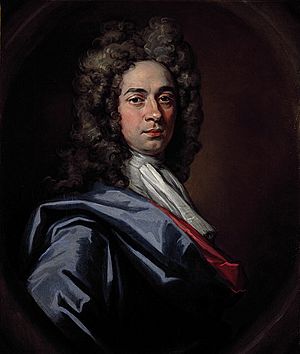John Baptist Medina facts for kids
Sir John Baptist Medina (born 1659 – died 5 October 1710) was a very skilled artist. He came from a Flemish-Spanish background. He spent most of his career working in England and Scotland. Medina was best known for painting portraits of people. He also made history as the first artist to draw pictures for John Milton's famous poem, Paradise Lost, in 1688.
His Life as a Painter
Medina was born in Brussels in 1659. His father was a captain in the Spanish army. John Baptist learned to paint from an artist named François Duchatel. In 1686, Medina moved to London and opened his own painting studio.
Even in London, he often painted people from Scotland. Around 1694, he moved to Edinburgh. He was invited by David Leslie, 3rd Earl of Leven. Medina stayed in Edinburgh for the rest of his life. He received a lot of support from the Earl of Melville. Medina had painted the Earl in London. The Earl of Melville was a powerful politician. He was Secretary of State for Scotland. This meant he helped run the country for the King.
Medina became the most important portrait painter in Scotland. There were not many other artists like him. He charged £5 for a painting of just a head. He charged £10 for a painting of half a person.
His most famous works are about 30 oval portraits. These include a self-portrait. They are kept at Surgeons' Hall, Edinburgh. People often compare them to the Kit Cat Club paintings by Sir Godfrey Kneller. Medina's style was similar to Kneller's. However, Medina's portraits often looked more relaxed. He liked to use bright blues and rose-red colors in the clothes. He also used dark backgrounds. The quality of his paintings could be different. This was probably because he had assistants helping him.
In 1706, Medina was made a knight. This was one of the last times Scottish knights were created before Scotland and England joined together in 1707.
Medina passed away in Edinburgh on 5 October 1710. He was buried in Greyfriars Kirkyard. This is a famous graveyard in the center of the city. His grave is a solid stone vault. It is on the east side of the graveyard.
Medina taught his own son how to paint. He also taught William Aikman. Aikman became the leading Scottish portrait painter of the next generation.
The Scottish National Portrait Gallery has ten of Medina's paintings. These include another self-portrait. Many of his paintings are still in Scotland. For example, the National Portrait Gallery, London does not have any of his works.
Illustrating a Famous Poem
Besides portraits, Medina also created other types of art. The only other works that we know of are his illustrations for Paradise Lost. This was a very famous poem by John Milton. Medina created eight engraved pictures for the fourth edition of the poem. This edition was published in London in 1688. It was the first time Paradise Lost had illustrations.
Some people have called his drawings "stiff." However, Medina's illustrations followed Milton's poem very carefully. Unlike other artists, he often included several different parts of the story in one picture. Medina used traditional religious images in his designs. He changed them in clever ways to fit Milton's poem. Medina's drawings appeared before Books 3 and 5 to 11 of the poem. A specialist engraver named Michael Burghers (also known as Burgese or Burgess) made the prints from Medina's designs. Burghers signed almost all of the plates. These illustrations were still used for the sixth edition of the poem in 1695. By then, they were quite worn out.
There is some debate about who drew some of the pictures. Based on a note by Horace Walpole, some people think Henry Aldrich drew certain plates. Aldrich was a scholar from Oxford. He was not known as an artist. Bernard Lens II, who painted small enamel pictures, signed one plate. Medina is signed as the artist for more plates than some experts think he actually drew.
Gallery of illustrations to Paradise Lost (1688)
-
Book 1: Satan Rousing the Rebel Angels. The artist for this is unknown, but it might be Henry Aldrich.
-
Book 2: Satan, Sin, and Death. The artist for this is unknown, but it might be Henry Aldrich.
-
Book 12: The Expulsion. The artist for this is unknown, but it might be Henry Aldrich.








